 | –≠–ª–µ–∫—Ç—Ä–æ–Ω–Ω—ã–π –∫–æ–º–ø–æ–Ω–µ–Ω—Ç: SA1638 | –°–∫–∞—á–∞—Ç—å:  PDF PDF  ZIP ZIP |

Philips
Semiconductors
SA1638
Low voltage IF I/Q transceiver
Product specification
1997 Sept 03
INTEGRATED CIRCUITS
IC17 Data Handbook
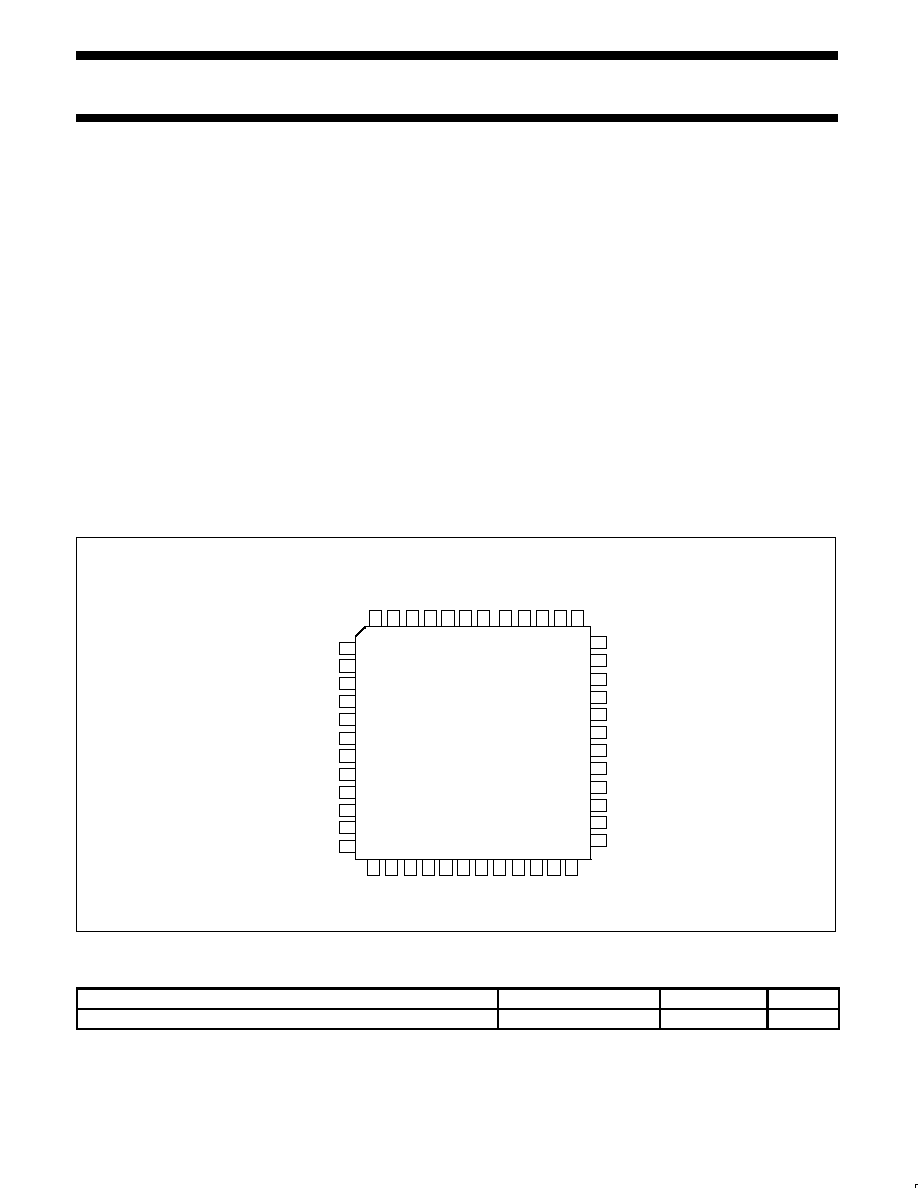
Philips Semiconductors
Product specification
SA1638
Low voltage IF I/Q transceiver
2
1997 Sept 03
853-1818 18351
DESCRIPTION
The SA1638 is a combined Rx and Tx IF I/Q circuit. The receive
path contains an IF amplifier, a pair of quadrature down-mixers, and
a pair of baseband filters and amplifiers. A second pair of mixers in
the transmit path transposes a quadrature baseband input up to the
IF frequency. An external VCO signal is divided down internally and
buffered to provide quadrature local oscillator signals for the mixers.
A further divider chain, reference divider and phase detector are
provided to avoid the need for an external IF synthesizer. Rx or Tx
path or the entire circuit may be powered down by logic inputs.
On-board voltage regulators are provided to allow direct connection
to a battery supply.
FEATURES
∑
Direct supply: 3.3V to 7.5V
∑
Two DC regulators giving 3.0V output
∑
Low current consumption: 18mA for Rx or 22mA for Tx
∑
Input/output IF frequency from 70-400 MHz
∑
Internal IF PLL for synthesizing the local oscillator signal
∑
High performance on-board integrated receive filters with
bandwidth tunable between 50-850 kHz
∑
Switchable alternative bandwidth setting available to allow
channel bandwidth flexibility in operation
∑
Designed for a widely used I and Q baseband GSM interface
∑
Control registers power up in a default state
∑
Optional DC offset trim capability to <200mV
∑
Only a standard reference input frequency required, choice of 13,
26, 39 or 52MHz
∑
Fully compatible with SA1620 GSM RF front-end (see Figure 9)
APPLICATIONS
∑
IF circuitry for GSM 900MHz hand-held units
∑
IF circuitry for PCN (DCS1800) hand-held units
∑
Quadrature up and down mixer stage
PIN CONFIGURATION
LQFP Package
CLK IN
CLK INX
VEEDIG
DATA
VEECP
IREF
LO INX
LO IN
ADJ IN
CLOCK
VREG1
VREGF2
VREG2
GNDREG2
PON
VBATT
AOUT
BOUT
DCRES
RESD
48≠pin LQFP
45
46
47
48
1
2
3
4
5
6
7
13 14
15 16 17 18 19
25
26
27
28
29
30
42
43
44
31
32
33
34
35
36
20
21 22 23 24
8
9
10
11
12
39
40
41
37
38
RESA
RESB
STROBE
LOCK
GNDREG1
VccTxRx
GND1
RxIF IN
RxIF INX
GND2
TxIFOUT
TxIFOUTX
GND3
PONPLL
VccCP
CP
PONRx
V
IRxOUT
IRxOUTX
QRxOUTX
ITx IN
ITx INX
QTx IN
QTx INX
PDTx
VccDIG
QRxOUT
SR00524
REF
Figure 1. SA1638 Pin Configuration
ORDERING INFORMATION
DESCRIPTION
TEMPERATURE RANGE
ORDER CODE
DWG #
48-Pin Thin Quad Flat Pack (LQFP)
-40 to +85
∞
C
SA1638BE
SOT313-2

Philips Semiconductors
Product specification
SA1638
Low voltage IF I/Q transceiver
1997 Sept 03
3
BLOCK DIAGRAM
RESA
RESB
V
REF
VREG1
GNDREG1
PON
V
BA
TT
GNDREG2
VREG2
V
CC
V
EE
CLK IN
CLK INX
DA
T
A
CLOCK
STROBE
ITx IN
ITx INX
QTx IN
QTx INX
IRxOUT
IRxOUTX
QRxOUT
QRxOUTX
PONRx
TxIFOUT
TxIFOUTX
GND1
RxIF IN
RxIF INX
LO IN
LO INX
LOCK
CP
IREF
PONPLL
VCCCP
VEECP
GND2
BIAS RX
BIAS TX
V.REG.1
V.REG.2
IF
AMP
BUFFERS
DC
ADJUST
DC
REGISTER
CHARGE
PUMP
PHASE
DETECTOR
TEST
REGISTER
13, 26
39, 52
SYNTH
REGISTER
SERIAL
INPUT
˜
2
˜
N
ADJ IN
DIG
DIG
STATUS
REGISTER
AOUT
BOUT
DCRES
GND3
VCCTxRx
PDTx
RESD
VREGF2
˜
SR00525
Figure 2. SA1638 Block Diagram
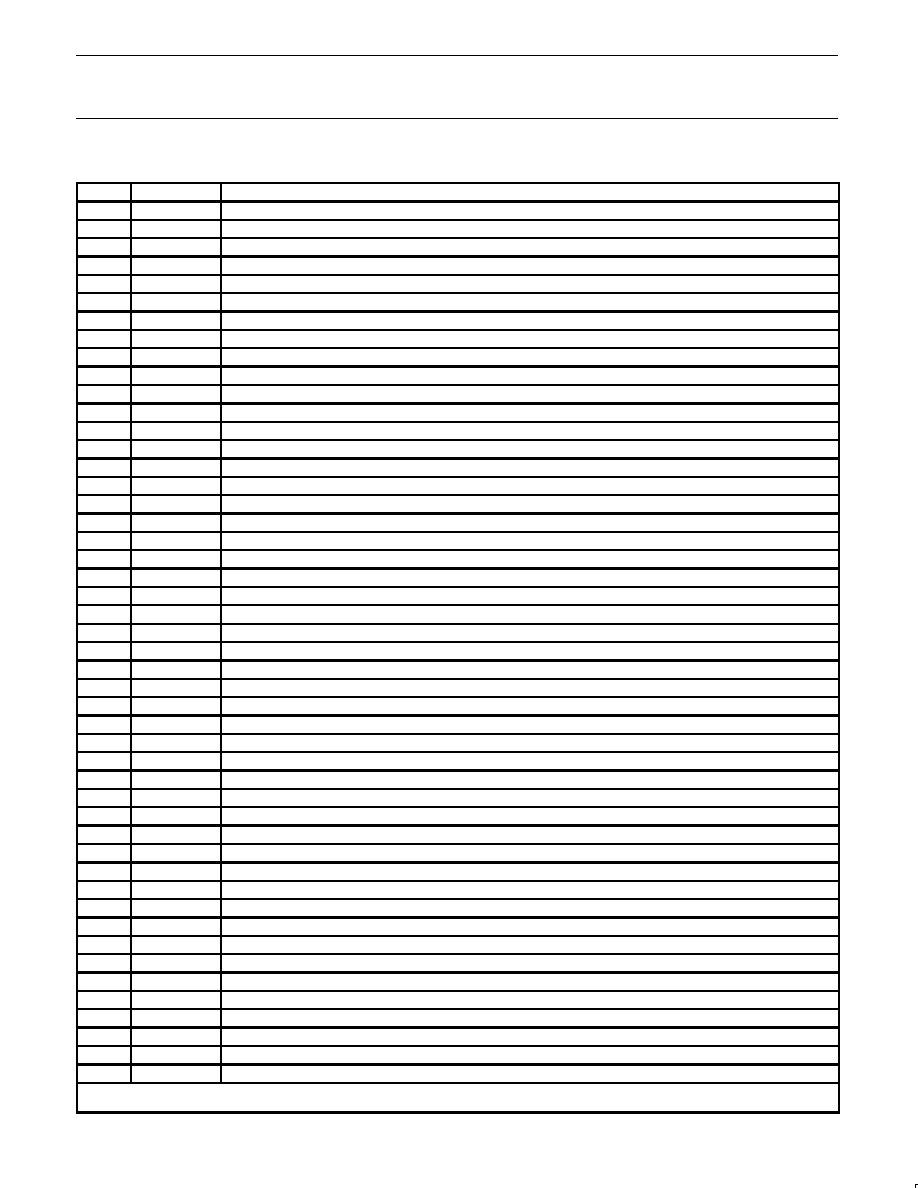
Philips Semiconductors
Product specification
SA1638
Low voltage IF I/Q transceiver
1997 Sept 03
4
PIN DESCRIPTIONS
Pin No.
Pin Name
Description
1
VREG1
Output voltage of regulator 1
2
VREGF2
Feedback of regulator 2
3
VREG2
Output voltage of regulator 2
4
GNDREG2
Ground of regulator 2
5
PON
Power-on input for voltage regulators 1 and 2 (active high)
6
V
BATT
Input voltage for regulators 1 and 2
7
AOUT
Programmable logic output (see Figure 9)
8
BOUT
Programmable logic output (see Figure 9)
9
DCRES
Reference current setting resistor for DC offset circuit
10
RESD
Additional external current defining resistor for filters
11
RESA
Principal external current defining resistor for filters
12
RESB
Principal external current defining resistor for filters
13
PONRx
Power-on input for Rx (active high)
14
V
REF
Reference voltage
15
QRxOUT
Differential receive baseband output
16
QRxOUTX
Differential receive baseband output
17
IRxOUT
Differential receive baseband output
18
IRxOUTX
Differential receive baseband output
19
QTx IN
Differential transmit baseband input
20
QTx INX
Differential transmit baseband input
21
ITx IN
Differential transmit baseband input
22
ITx INX
Differential transmit baseband input
23
PDTx
Power-on for transmitter (active low)
24
V
CC
DIG
Digital circuit supply
25
V
EE
DIG
Digital ground
26
DATA
Serial bus data input
27
CLOCK
Serial bus clock input
28
STROBE
Serial bus strobe input
29
LOCK
Test control/synthesizer lock indicator
30
CLK INX
Differential reference divider input
31
CLK IN
Differential reference divider input
32
ADJ IN
Used for test only. Do not connect
33
LO IN
Differential LO input
34
LO INX
Differential LO input
35
I
REF
Reference current setting for charge pump
36
V
EE
CP
Charge pump ground
37
CP
Charge pump output
38
V
CC
CP
Charge pump circuit supply
39
POnPLL
Power-on input for synthesizer circuits (active high)
40
GND3
Ground (internal connection to GND1 and GND2)
41
TxIFOUTX
Differential transmit IFoutput (open collector)
42
TxIFOUT
Differential transmit IFoutput (open collector)
43
GND2
Ground (internal connection to GND1 and GND3)
44
RxIF INX
Differential receive IF input
45
RxIF IN
Differential receive IF input
46
GND1
Ground (internal connection to GND2 and GND3)
47
V
CC
TxRx
Transmit and receive circuits supply voltage (also feedback of Regulator 1)
48
GNDREG1
Ground of regulator 1
NOTE: There are no ESD protection diodes at Pins 41 and 42. Thus, open collector outputs may have increased DC voltage or higher AC
peak voltage.

Philips Semiconductors
Product specification
SA1638
Low voltage IF I/Q transceiver
1997 Sept 03
5
ABSOLUTE MAXIMUM RATINGS
SYMBOL
PARAMETER
RATING
UNITS
V
CC
XXX
Supply voltages: V
CC
TxRx, V
CC
DIG, V
CC
CP
-0.3 to +6.0
V
V
BATT
Battery voltage
-0.3 to +8.0
V
V
IN
Voltage applied to any other pin
-0.3 to (V
CCXXX
+0.3)
V
VG
Any GND pin to any other GND pin
0
V
P
D
Power dissipation, T
A
= 25
∞
C (still air)
300
mW
T
JMAX
Maximum operating junction temperature
150
∞
C
P
MAX
Maximum power input/output
+20
dBm
T
STG
Storage temperature range
≠65 to +150
∞
C
NOTE:
1. Maximum dissipation is determined by the operating ambient temperature and the thermal resistance,
JA
. 48-pin LQFP:
JA
= 67
∞
C/W.
RECOMMENDED OPERATING CONDITIONS
SYMBOL
PARAMETER
RATING
UNITS
V
CC
XXX
Supply voltages: V
CC
TxRx, V
CC
DIG
2.7 to 5.5
V
V
CC
CP
Charge pump supply voltage
2.9 to 5.5
V
V
BATT
Battery voltage
3.3 to 7.5
V
T
A
Operating ambient temperature range
-40 to +85
∞
C
Voltage Regulators
T
A
= 25
∞
C, P
ON
= 3V, P
ON
RX = 0V, PDTX = 3V, P
ON
PLL = 0V, V
BATT
= 3.3V, I
OUT
1 = I
OUT
2 = 15mA, V
REG
1 connected to V
CC
TxRx, V
REG
2
connected to V
REG
F2; V
CC
DIG = V
CC
CP = 3V; unless otherwise stated.
SYMBOL
PARAMETER
TEST CONDITIONS
LIMITS
UNITS
SYMBOL
PARAMETER
TEST CONDITIONS
Min
≠3
Typ
+3
Max
UNITS
V
REG
1,
V
REG
2
Nominal V
OUT
2.85
2.93
3.00
3.07
3.15
V
V
BATT
3.3
7.5
V
I
OUT
1, I
OUT
2
Maximum output current for each
regulator
1
30
mA
I
BATT
Supply current for both regulators
I
LOAD
= 0mA
4.3
5
5.7
7
mA
I
BATT PD
Power-down supply current
P
ON
= 0V, I
LOAD
= 0mA
7.7
9
10.3
15
µ
A
C
REG
1
2
V
REG
1 cap load
0.1
1000
µ
F
C
REG
2
2
V
REG
2 cap load
0.1
500
µ
F
LINEREG
Line regulation
DC, V
BATT
= 3.3V to 7.5V
≠0.4
≠0.2
0.001
0.2
0.4
%
LOADREG
Load regulation
I
LOAD
= 15mA to 30mA
≠5
≠0.37
-0.17
0.03
5
%
BW
Bandwidth
100
kHz
F
PON
Feedthrough attenuation from P
ON
to
each regulator
-40
dB
F
REG
Feedthrough attenuation from V
BATT
to
each regulator
f
100kHz
f = 10MHz
f = 100MHz
f = 400MHz
-61
-32
-37
-48
dB
t
ON
Turn ON time
10
µ
s
NOTES:
1. At T
j
150
∞
C a thermal switch reduces the output current to avoid damage.
2. Recommended load capacitors: In every case C
REG
1 = C
REG
2 = 100nF to ground with series resistance
0.1
. Additional capacitor
optional
1000
µ
F with series resistance
5
. The low series resistance is very important to ensure regulator stability.
3. Standard deviations are based on the characterization results of 90 ICs.

Philips Semiconductors
Product specification
SA1638
Low voltage IF I/Q transceiver
1997 Sept 03
6
DC ELECTRICAL CHARACTERISTICS
V
CC
TxRx=V
CC
DIG=V
CC
CP=PONRx=PONPLL= +3V; V
EE
DIG = V
EE
CP=GND1=GND2=GND3=PDTx = 0V; T
A
= 25
∞
C, unless otherwise stated.
SYMBOL
PARAMETER
TEST CONDITIONS
LIMITS
UNITS
SYMBOL
PARAMETER
TEST CONDITIONS
MIN
≠3
TYP
+3
MAX
UNITS
Supply current
Rx and IF synthesizer active
PONRx = PONPLL = PDTx = Hi
14.4
16
17.6
20
I
CC
Tx and IF synthesizer active
PONRx = PDTx = Low;
PONPLL = Hi
17.4
19.5
21.6
24
mA
Power-down mode
PONRx = PONPLL = Low;
PDTx = Hi
0.068
V
REF
Reference voltage
Generated internally
1.39
1.57
1.75
V
IV
REF
V
REF
I
SINK
I
SOURCE
5
5
µ
A
I
OUT
DC output current
At pins TxIFOUT and
TxIFOUTX
1.5
1.86
2.0
2.14
2.7
mA
Digital inputs (P
ON
)
V
IH
High level input voltage range
2.0
V
BATT
V
V
IL
Low level input voltage range
0
0.8
V
Digital inputs (PDTx, P
ON
Rx, P
ON
PLL, P
ON
)
V
IH
High level input voltage range
2.0
V
CC
TxRx
V
V
IL
Low level input voltage range
0
0.8
V
Digital inputs (Clock, Data, Strobe)
V
IH
High level input voltage range
2.0
V
CC
Dig
V
V
IL
Low level input voltage range
0
0.8
V
Digital outputs (LOCK, AOUT, BOUT)
V
OH
Output voltage HIGH
I
O
= -2mA
V
CC
DIG≠0.4
V
V
OL
Output voltage LOW
I
O
= 2mA
0.4
V
AC ELECTRICAL CHARACTERISTICS
V
CC
TxRx=V
CC
DIG=V
CC
CP=PONRx=PONPLL= +3V; V
EE
DIG = V
EE
CP=GND1=GND2=GND3=PDTx = 0V; LO
IN
= 100mV
PEAK
,
800MHz;
CLK
IN
= 100mV
PEAK
, 52MHz; serial registers programmed with default values; T
A
= 25
∞
C unless otherwise stated. Test Circuit Figure 8.
SYMBOL
PARAMETER
TEST CONDITIONS
LIMITS
UNITS
SYMBOL
PARAMETER
TEST CONDITIONS
MIN
≠3
TYP
+3
MAX
UNITS
IF Transmit Modulator
BW
Input modulation bandwidth
200
source impedance
0.82
0.94
1.06
MHz
V
COM
Common mode range for
baseband inputs
DC at pins ITxIN, ITxINx,
QTxIN, QTxINx
1
1.5
2
V
V
IN
Peak input signal amplitude
Centered on V
COM
0.75
V
Third harmonic distortion
1
| ITxIn | = | ITxInX | =
| QTxIn | = | QTxInX |
= 0.75V
PEAK;
fin = 20kHz
-61
-57
-53
-40
dB
R
INTx
Input resistance
Between pins: ITxIn and
ITxInX or QTxIn and
QTxInX
112
k
C
INTx
Input capacitance
At ITxIn, ITxInX,
QTxIn, QTxInX
10
pF
Output saturation limit
V
CC
TxRx-0.3
V
I
OUT
RMS output current
| ITxIn | = | ITxInX | =
| QTxIn | = | QTxInX |
= 0.75V
PEAK
0.6
0.73
0.82
0.91
1.08
mA
S
LO
LO suppression
1
| ITxIn | = | ITxInX | =
| QTxIn | = | QTxInX |
= 0.75V
PEAK
; fin = 20k
+30
+43
dB
SSB
Sideband suppression
1
| ITxIn | = | ITxInX | =
| QTxIn | = | QTxInX |
= 0.75V
PEAK
; fin = 20k
+35
+50
dB

Philips Semiconductors
Product specification
SA1638
Low voltage IF I/Q transceiver
1997 Sept 03
7
AC ELECTRICAL CHARACTERISTICS
(Continued)
SYMBOL
PARAMETER
TEST CONDITIONS
LIMITS
UNITS
SYMBOL
PARAMETER
TEST CONDITIONS
MIN
≠3
TYP
+3
MAX
UNITS
IF Transmit Modulator (continued)
Noise density at 600kHz
|ITxIn| = |ITxInX| = |QTxIn| =
-130
-129
-128
dBc/Hz
Noise density at 10MHz
|QTxInX| = 0.75V
PEAK
-133
-131
-129
dBc/Hz
t
ON
Turn ON time
PdTx = LO, transmit signal to 90%
5
µ
s
t
OFF
Turn OFF time
PdTx = HI, transmit signal to 10%
5
µ
s
IF Receiver (R = 36k
between pins RESA and RESB)
RInRx
Differential input impedance
f
IN
= 400MHz
5 || 0.6
k
|| pF
ROutRx
Output impedance
1
k
Output common mode voltage
V
REF
V
f3dB
Low pass filter -3dB bandwidth
70
83
90
kHz
Low pass filter attenuation:
200kHz
400kHz
600kHz
6.5MHz
13.0MHz
6.5
30
8.9
38.1
10.7
45
70
>80
>80
12.5
51.9
dB
VG
Voltage gain
Differential output PD into GSM
baseband relative to 1200
source EMF
43
49.4
51
52.7
58
dB
NF
Noise figure
8
1200
source and external
matching resistor and inductor
5.7
7.0
8.3
dB
Channel matching:
Gain
Phase
f
IN
= 400.005MHz
-1.5
-0.26
0.0
1.5
dB
degrees
Output DC offset
2
Differential, DCRES=562k
-60
-25
60
mV
I
OUT
Output drive current at each pin
Source (Sink)
10 (700)
µ
A
V
OUT
Minimum differential output swing
2.0
V
P
-1dB
Input 1dB compression point:
In band
200kHz
400kHz
600kHz
1200
source EMF
-59
-54
-55.3
-49.3
-53
-47
-47
-47
-50.7
-44.8
-47
-40
dBV
t
ON
Turn ON time
3
POnRx = HI, to baseband signal
out
2
µ
s
t
OFF
Turn OFF time
POnRx = LO, to no baseband
signal out
2
µ
s
IF Synthesizer
f
LO
Local oscillator input frequency
range
9
140
800
MHz
Z
LOIN
Differential input impedance
Between pins LO
IN
and LO
IN
X, f
IN
= 800MHz
276 || 0.6
|| pF
V
LOIN
LO peak input voltage range
Single-ended
Referred to 50
50
100
mV
Programmable divider:
Division range
Step size
64
1
511
f
CLKIN
Reference clock input frequency
V
CLKIN
= 100mV
PEAK
52
MHz
Z
CLKIN
Differential input impedance
Between pins ClkIn and ClkInX
10 || 1.0
k
|| pF
V
CLKIN
CLK
IN
peak input voltage range
Single-ended, referred to 50
50
400
mV
I
REF
Charge pump input reference
current
31.2
µ
A
| I
CP
|
Charge pump output current:
c0...c2 = 000
c0...c2 = 111
Step size
I
REF
=31.2
µ
A,
V
CP
= V
CC
CP/2
0.425
0.85
0.045
0.487
0.979
0.062
0.5
1.0
0.071
0.513
1.021
0.08
0.575
1.15
0.105
mA
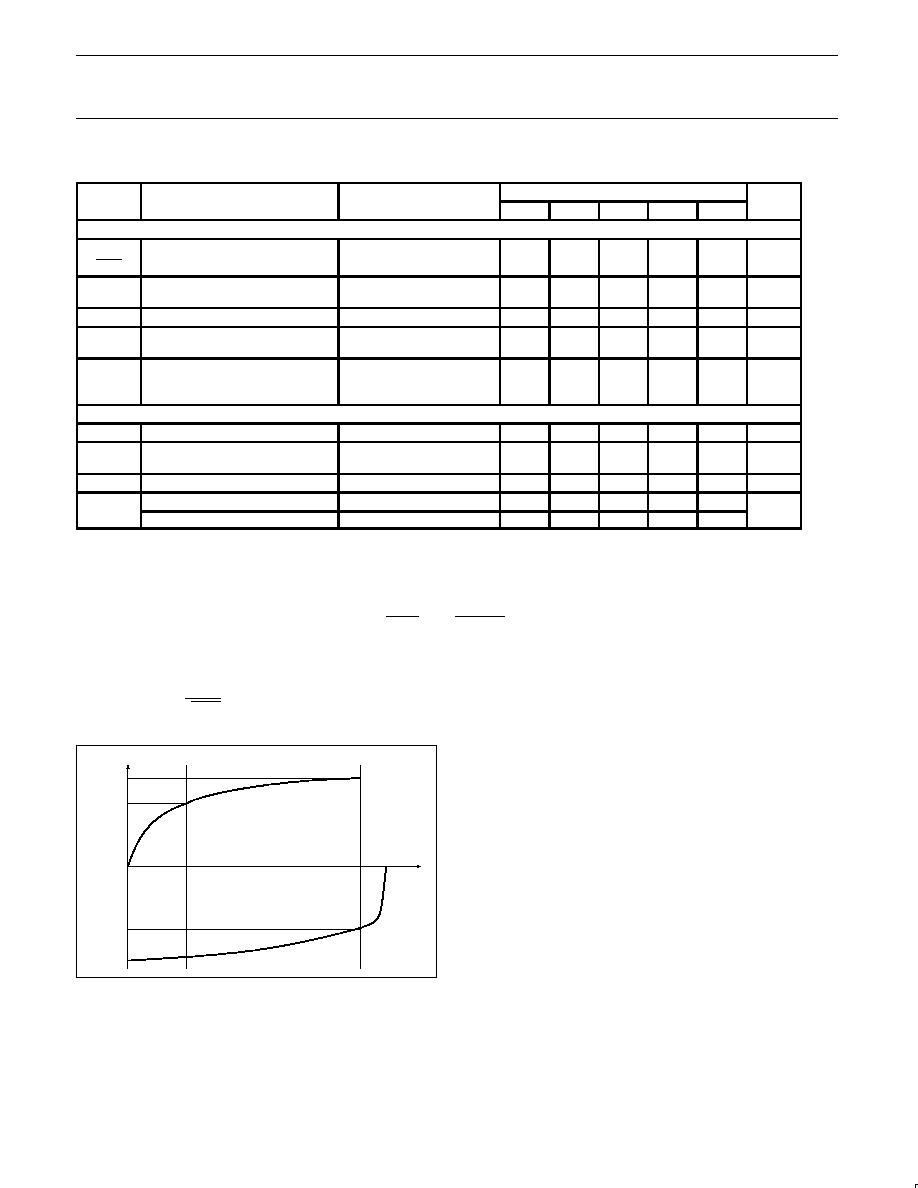
Philips Semiconductors
Product specification
SA1638
Low voltage IF I/Q transceiver
1997 Sept 03
8
AC ELECTRICAL CHARACTERISTICS
(Continued)
SYMBOL
PARAMETER
TEST CONDITIONS
LIMITS
UNITS
SYMBOL
PARAMETER
TEST CONDITIONS
MIN
≠3
TYP
+3
MAX
UNITS
IF Synthesizer (cont.)
D
I
CP
I
CP
Relative output current variation
4
I
REF
=31.2
µ
A
0.1
1.3
2.5
±
10
%
I
CP_M
Output current matching
5
I
REF
=31.2
µ
A,
V
CP
= V
CC
CP/2
±
12
%
|I
CP_L
|
Output leakage current
V
CP
= 0.3V to V
CC
CP-0.3V
-0.02
0.1
0.22
±
15
nA
t
ON
Turn ON time
POnPLL = HI, to full charge
pump current
15
µ
s
t
OFF
Turn OFF time
6
POnPLL = LO, to I
CC
CP,
I
CC
DIG <5% of operational
supply current
15
µ
s
Serial Interface
7
f
CLOCK
Clock frequency
10
MHz
t
SU
Set-up time: DATA to CLOCK,
CLOCK to STROBE
30
ns
t
H
Hold time: CLOCK to DATA
30
ns
t
W
Pulse width: CLOCK
30
ns
t
W
Pulse width: STROBE
30
ns
NOTES:
1. Parameter measured relative to modulation sideband amplitude.
2. After programming the DC offset register for minimum offset. DCRES = 562k
.
3. The turn on time relates only to the power up time of the circuit. The settling time of the integrated baseband filters has to be added (for
GSM≠mode = 8
µ
s with filter bandwidth setting resistor = 36k
).
4. The relative output current variation is defined thus:
D
I
OUT
I
OUT
+
2
@
(I
2
*
I
1
)
|(I
2
)
I
1
)|
; with V
1
= 0.3V, V
2
= V
CC
CP ≠ 0.3V (see Figure 3).
5. The output current matching is measured when both (positive current and negative current) sections of the output charge pumps are on.
6. As soon as P
ON
PLL is set to LO, the phase detector is reset and no charge pumps pulses are generated.
7. Guaranteed by design.
8. NF =
20 log
E
no
4kTR
*
VG where, E
no
is the output noise voltage measured in a 1Hz bandwidth, R = 1200
, VG = gain in dB.
9. Minimium frequency is guaranteed by design.
I2
I1
I2
I1
V1
V2
CURRENT
VOLTAGE
SR00526
Figure 3. Relative Output Current Variation
FUNCTIONAL DESCRIPTION
Serial Programming Input
The serial input is a 3-wire input (CLOCK, STROBE, DATA) to
program the counter ratios, charge pump current, status- and
DC-offset register, mode select and test register. The programming
data is structured into two 21-bit words; each word includes 4 chip
address bits and 1 subaddress bit. Figure 2 shows the timing
diagram of the serial input. When the STROBE = L, the clock driver
is enabled and on the positive edges of the CLOCK the signal on
DATA input is clocked into a shift register. When the STROBE = H,
the clock is disabled and the data in the shift register remains stable.
Depending on the value of the subaddress bit the data is latched
into different working registers. Table 3 shows the contents of each
word.
Default States
Upon power up (V
CC
DIG is applied) a reset signal is generated,
which sets all registers to a default state. The logic level at the
STROBE pin should be low during power up to guarantee a proper
reset. These default states are shown in Table 3.
Reference Divider
The reference divider can be programmed to four different division
ratios (:13, :26, :39, :52), see registers r0, r1; default setting: divide
by 13.
Main Divider
The external VCO signal, applied to the LO
IN
and LO
IN
X inputs, is
divided by two and then fed to the main divider (:N). The main
divider is a programmable 9 bit divider, the minimum division ratio is

Philips Semiconductors
Product specification
SA1638
Low voltage IF I/Q transceiver
1997 Sept 03
9
divide by 64. The division ratio is binary coded and set in the
registers n0 to n8. The default setting is a divide by 400.
At the completion of a main divider cycle, a main divider output is
generated which will drive the phase detector.
Phase Detector
The phase detector is a D-type flip-flop phase and frequency
detector shown in Figure 5. The flip-flops are set by the negative
edges of the output signals of the dividers. The rising edge of the
signal L will reset the flip-flops after both flip-flops have been set.
Around zero phase error this has the effect of delaying the reset for
1 reference input cycle. This avoids non-linearity or deadband
around zero phase error. The flip-flops drive on-chip charge pumps.
A source current from the charge pump acts to increase the VCO
frequency; a sink current acts to decrease the VCO frequency.
Current Setting
The charge pump current is defined by the current set between the
pin I
REF
and V
EE
CP. The current value to be set there is 31.2
µ
A.
This current can be set by an external resistor to be connected
between the pin I
REF
and V
EE
CP. The typical value R
EXT
(current
setting resistor) can be calculated with the formula
R
EXT
+
V
CC
CP
*
1.4V
31.2
m
A
The current can be set to zero by connecting the pin I
REF
to V
CC
CP.
Charge Pumps
The charge pumps at pin CP are driven by the phase dectector and
the current value is determined by the binary value of the charge
pumps register CN = c2, c1, c0, default 1mA. The active charge
pump current is typically:
|I
CP
|
+
(c0
)
2c1
)
4c2)
@
71
m
A
)
500
m
A
Lock Detect
The output LOCK is H when the phase detector indicates a lock
condition. This condition is defined as a phase difference of less
than
±
1 cycle on the reference input CLK
IN
, CLK
IN
X.
Test Modes (Synthesizer, Transmit Mixer)
The LOCK output is selectable as a test output. Bits x0, x1 control
the selection, the default setting is normal lock output as described
in the Lock detect section. The selection of a Bit x0, x1 combination
has a twofold effect: First it routes a divider output signal to the
LOCK pin, second it disables mixer stages in the transmit path.
Setting x0,1 = 11 disables both transmit path mixers. This mode can
be used to prevent the transmitter from producing an IF output
signal even if the transmit part is powered on (PDTx = 0V). This can
be used to simplify the control timing while commanding the transmit
and receive simultaneously without the transmit part causing
interference.
Table 1.
Test Modes
x0
x1
Synthesizer Signal
Transmit Mixer
x0
x1
y
g
at LOCK Pin
Q-mixer
I-mixer
0
0
normal lock detect
on
on
1
0
CLK
IN
divided by reference
divider ratio
off
on
0
1
LO
IN
˜
2 * (main divider ratio)
on
off
1
1
main divider output, that goes to
the phase detector
off
off
Status Register
The s0 and s1 status bits determine the values of the logic output
pins A
OUT
and B
OUT
. These outputs can be connected to the AGC
control inputs A and B of the SA1620. (See Figure 9)
DC Offset Register
Registers i0 to i3 and q0 to q3 control a correction to the output DC
offset of the I and Q channels of the receiver. The polarity of the DC
offset correction in the I and Q channels are determined by i0 and
q0, respectively. The other bits set the magnitude of the offset
correction. The step size of the two offset correction DACs is fixed
by an external resistor between the DCRES pin and ground. A
value of 120k
will give a step size of 200mV.
Mode Select Register
t0:
switches the RX IF gain.
t0 = 0
no attenuation
t0 = 1
10dB attenuation
The attenuation switch is included between the IF amplifier and the I
and Q mixers, thereby influencing the noise figure negligibly. The
purpose of this switch is to provide another AGC step which does
not influence the receiver noise figure. Please note that this gain
change will influence the DC offset of the I and Q mixers.
t1 = 0 test mode only, always to be set to 0.
t2, t3 sets the mode of the level locked loop (LLL)
The LLL is a circuit which processes the LO input signal in order to
provide an LO signal with a perfect 50% duty cycle, which
determines the precision of the 90
∞
shift of the I and Q mixing
signals generated by the
˜
2 divider. For an external tuning of the
90
∞
phase shift of the I and Q mixing signals, a trimming resistor
may be connected (but is not required) between the ADJ
IN
pin and
ground, and the LLL has to be put in one of the following modes:
Table 2.
Mode Select Register
t2
t3
LLL Status
0
0
LLL on (no external tune, monitor performance, default)
0
1
LLL on (with medium external tune)
1
0
LLL off (tune externally)
1
1
LLL on (with fine external tune)
t4
selects the bandwidth of the RC low pass filters at the I, Q
Rx mixer outputs
t4 = 0
cutt-off frequency (-3dB) 110kHz
t4 = 1
cutt-off frequency (-3dB) 792kHz
t5
selects the bandwidth of the integrated 5th-order gyrator
filters. The filters are tuneable over a range of 50kHz to
1MHz with external resistors. The -3dB bandwidth is
inversely proportional to the value of the external resistor.
With
t5, two external resistor values are selectable.
t5 = 0
the resistance between the pins RESA and
RESB determines the cutoff frequency. For
GSM a nominal bandwidth of 80kHz is chosen
when the external resistor is 36k
.
t5 = 1
a second resistor between the pins RESB and
RESD is connected in parallel to the first
external resistor, thus increasing the filter
bandwidth. The relative amplification is
decreased in this mode.

Philips Semiconductors
Product specification
SA1638
Low voltage IF I/Q transceiver
1997 Sept 03
10
The overall filter response in the receive section is the sum of the
filter responses of the passive RC low-pass filter and the active
gyrator filter.
Power Down Modes
There are 4 power-on pins in the SA1638: P
ON
, P
ON
Rx, PDTx,
P
ON
PLL.
P
ON
= H powers up both voltage regulators V
REG
1 and V
REG
2. P
ON
should be set to L, if these internal voltage regulators are not to be
used.
P
ON
Rx = H powers up the receiver part.
PDTx = L powers up the transmitter part.
P
ON
PLL = H powers up the synthesizer part. As it also powers up
the first divide by 2 stage for generating the 0/90 degree phase
shifted signals for the transmit and receive mixers, it also has to be
set H if either the transmit part or the receive part is used. P
ON
PLL
= L powers down the dividers, resets the phase detector and
disconnects the current setting pin I
REF
. In P
ON
PLL = L mode, the
values in the serial input registers are still kept and the part still can
be reprogrammed as long as V
CC
DIG is present.
Table 3.
Definition of SA1638 Serial Registers
First data word: (shown with default values)
Address SA1638
Sub
Adr
N-Divider
Ref
˜
Reg
Charge-Pump
Reg Test
MSB
LSB
a0
a1
a2
a3
sa
n0
n1
n2
n3
n4
n5
n6
n7
n8
r0
r1
c0
c1
c2
x0
x1
1
1
1
0
0
1
1
0
0
1
0
0
0
0
0
0
1
1
1
0
0
Address:
4 bits, a0...a3, fixed to 1110
Sub:Address:
1 bit, sa, fixed to 0 for first data word
N-Divider:
9 bits, n0...n8, values 64 (00100 0000) to 511 (111111111) allowed for IF-choice, default 400
Reference Divider Register:
2 bits, r0...r1, 00 =
˜
13, 01 =
˜
26, 10 =
˜
39, 11 =
˜
52. Default: 00
Charge-Pump Register:
3 bits, c0...c2, Binary current setting factor for charge pumps, values 000 = minimum current to 111 =
maximum current, default maximum charge pump current
Test Register:
2 bits, x0...x1, default 00, see Functional Description
Second data word: (shown with default values)
Address SA1638
Sub
Status
DC Offset Register
Mode Select Register
Address SA1638
Adr
Reg
Q-Channel
I-Channel
Mode Select Register
MSB
LSB
a0
a1
a2
a3
sa
s0
s1
q0
q1
q2
q3
i0
i1
i2
i3
t0
t1
t2
t3
t4
t5
1
1
1
0
1
1
1
0
0
0
0
0
0
0
0
0
0
0
0
0
0
Address:
4 bits, a0...a3, fixed to 1110
Sub:Address:
1 bit, sa, fixed to 1 for second data word
Status Register:
2 bits, s0 sets pin A
OUT
; s1 sets pin B
OUT
, see Functional Description
DC Offset Register:
4 bits per channel, i0...i3 and q0...q3, no correction as default
i0 and q0 switches offset polarity, 0 to lower voltage, 1 to higher voltage
il...i3 and q1...q3, 000 no correction to 111 max. correction enabled
Mode Select Register:
6 bits,
t0...t5,
000000 = normal GSM-Operation as default, see Functional Description

Philips Semiconductors
Product specification
SA1638
Low voltage IF I/Q transceiver
1997 Sept 03
11
CLOCK ENABLED
SHIFT IN DATA
CLOCK
DISABLED
STORE DATA
FIRST CLOCK
LAST CLOCK
FIRST CLOCK
CLOCK
DATA
LSB
MSB
STROBE
CLOCK
50%
STROBE
tSU
tSU
tH
tSU
X1 or t5
X0 or t4
a1
a0
50%
tW
SR00527
Figure 4. Serial Input Timing Sequence
REFERENCE
DIVIDER
MAIN
DIVIDER
D
C
R
Q
"1"
N
N-TYPE
CHARGE PUMP
P-TYPE
CHARGE PUMP
X
R
D
R
Q
C
"1"
˜
2
CLKIN
LOIN
CP
P
VSS
VCCCP
CLKIN
L
R
X
P
N
ICP
SR00528
L
Figure 5. Phase Detector Structure with Timing
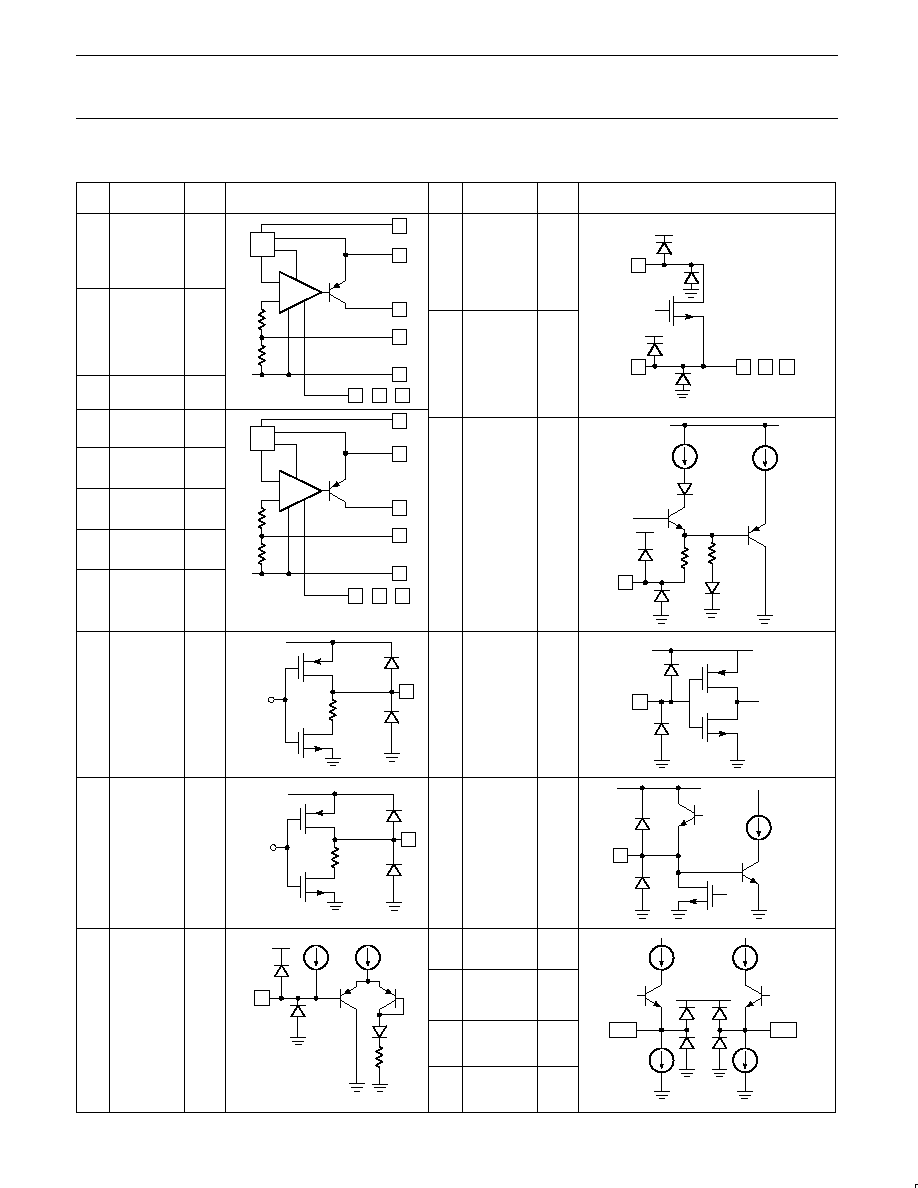
Philips Semiconductors
Product specification
SA1638
Low voltage IF I/Q transceiver
1997 Sept 03
12
PIN FUNCTIONS
5
1
13
14
PIN
No.
PIN
MNEMONIC
DC V
EQUIVALENT CIRCUIT
PIN
No.
PIN
MNEMONIC
DC V
EQUIVALENT CIRCUIT
47
V
CC
TxRx
3.0
13
P
ON
Rx
3.0
12
RES
B
0.05
10
RES
D
0.05
BG
+
--
47
6
48
40
43
46
48
GND
REG
1
0.0
1
V
REG
1
3.0
5
3
BG
+
--
2
6
4
40
43
46
1.2
2.5
35k
25k
1.2
2.5
35k
25k
2
V
REG
F2
3.0
3
V
REG
2
3.0
4
GND
REG
2
0.0
5
P
ON
3.3
6
V
BATT
3.3
7
6
V
BATT
3.3
7
A
OUT
3.0
8
8
B
OUT
3.0
9
9
DC
RES
1.6
10
11
40
43
46
t5
11
RES
A
0.00
12
14
V
REF
1.5
15, 17
16, 18
15
QRX
OUT
1.5
16
QRX
OUT
X
1.5
17
IRX
OUT
1.5
18
IRX
OUT
X
1.5
SR00529
Figure 6. Pin Functions
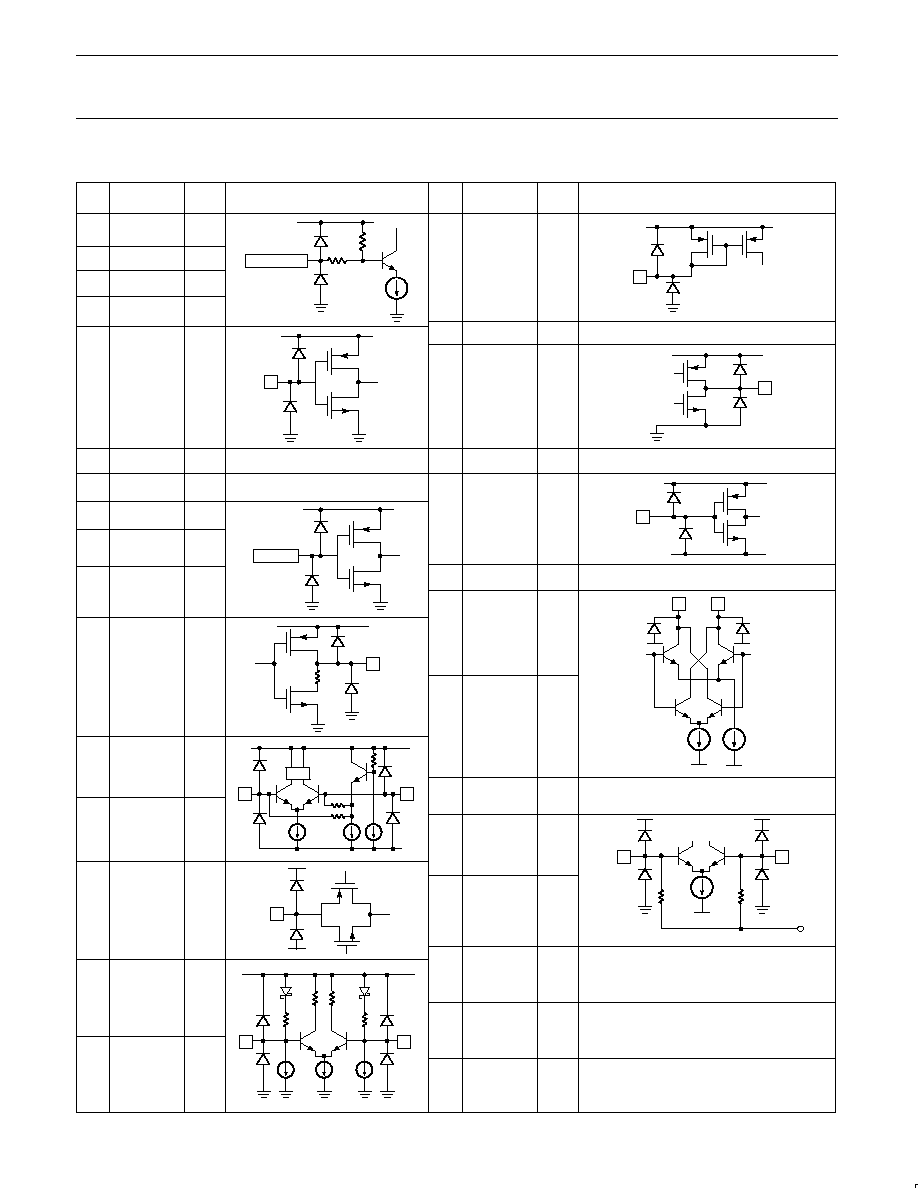
Philips Semiconductors
Product specification
SA1638
Low voltage IF I/Q transceiver
1997 Sept 03
13
PIN FUNCTIONS (continued)
PIN
No.
PIN
MNEMONIC
DC V
EQUIVALENT CIRCUIT
PIN
No.
PIN
MNEMONIC
DC V
EQUIVALENT CIRCUIT
QTX
IN
1.5
23
0.0
35
I
REF
1.6
PdTx
24
3.0
V
CC
DIG
29
LOCK
31
CLK
IN
X
2.0
19
19, 20, 21, 22
QTX
INX
1.5
20
ITX
IN
1.5
21
ITX
INX
1.5
22
23
25
3.0
V
EE
DIG
26, 27, 28
26
DATA
27
CLOCK
28
STROBE
29
30
31
30
CLK
IN
2.0
32
32
ADJ
IN
2.0
35
36
0.0
V
EE
CP
37
37
CP
38
3.0
V
CC
CP
39
39
3.0
P
ON
PLL
40
0.0
GND3
41
42
41
TXIF
OUT
X
OPEN
COLLECTOR
42
TXIF
OUT
X
OPEN
COLLECTOR
33
2.0
LO
IN
34
2.0
LO
IN
X
43
0.0
GND2
44
45
44
RxIF
IN
X
45
RxIF
IN
1.5
1.5
46
GND1
0.0
47
V
CC
TxRx
3.0
48
GND
REG
1
0.0
33
34
V
REF
SR00530
Figure 7. Pin Functions (cont.)

Philips Semiconductors
Product specification
SA1638
Low voltage IF I/Q transceiver
1997 Sept 03
14
Overview of Dual GSM/PCN Architecture
The SA1620 RF front-end and SA1638 IF transceivers form a dual
conversion architecture which uses a common IF and standard I/Q
baseband interface for both transmit and receive paths. The time
division multiplex nature of the GSM system permits integration of
the transmit and receive functions together on the one RF and one
IF chips. This simplifies the distribution of local oscillator signals,
maximizes circuitry commonality, and reduces power consumption.
The SA1620 and SA1638 allow considerable flexibility to optimize
the transceiver design for particular price/size/performance
requirements, through choice of appropriate RF and IF filters. The
IF may be chosen freely in the range 70≠400 MHz. The same IF
can be used in the transmit and receive directions. Alternately,
different IFs can be used if the SA1638 synthesizer frequency is
switched between transmit and receive timeslots. The comparison
frequency of the SA1638 PLL is high in order to provide fast
switching time.
With suitable choice of the IF, an identical SA1638 IF receiver
design can be used for both 900MHz GSM and 1800MHz PCN
(DCS1800) equipment.
General Benefits/Advantages
∑
2.7V operation. Compatible with 3V digital technology and
portable applications. (Higher voltage operation also possible, if
desired.)
∑
Excellent dynamic range. The availability of two LNAs in the
SA1620 allows flexibility in receiver dynamic design for portable
and mobile GSM spec. applications with appropriate filters. If for
a particular application a GaAs or discrete front-end is desired,
one of the LNAs can be left unpowered. Placing the AGC gain
switches at the front results in some attenuation most of the time,
further increasing typical dynamic performance beyond that
specified by GSM.
∑
High power transmit output driver, delivering +7.5dBm output.
This is sufficient to drive a filter and power amplifier input, without
a driver amplifier. To avoid unnecessary current consumption, the
output power can be reduced to an appropriate level by choice of
an external resistor.
∑
DC offsets generated in the receive channel are independent of
the LNA AGC setting, and correctable by software to prevent
erosion of signal handling dynamic range by DC offsets.
∑
Minimal high-quality filter requirements. As a result of the
integration in the SA1638 of high quality channel selectivity filters,
only sufficient filtering is needed in the receive path to provide
blocking protection for the second mixers. This reduces receiver
cost and size.
∑
Operation at a high IF allows RF image reject filter requirements
to be relaxed. For example, at a 400MHz IF, the natural gain
roll-off in the SA1620 LNAs and mixer suppresses the image
signal in the 1800MHz band by typically 28dB below the desired
900MHz band signal.
DC Offset Correction
DC offset correction is provided by two DACs each feeding into one
of the two Rx channels. The step size of both DACs is set by the
value of the external resistor between DCRES and ground. Thus
any original offset less than 1.5V magnitude in either channel can be
reduced to the specified level by selecting the appropriate DAC
setting via the serial interface.
Integrated Receive Filters
The low-pass characteristics of the Rx channel are determined by
two low-pass responses. The first of these is a passive filter at the
output of the quadrature mixers and the second is the low-pass
filters which follow the post-mixer amplifiers. These specifications
refer only to the response of the default state, but this may be
switched by the control register to an alternative setting with a
nominal 3dB point of 792kHz.
The corner frequency of the low pass filters can be adjusted over a
wide range by varying the value of the external resistor between
RESA and RESB. The range of feasible corner frequencies extends
at least between 50kHz and 500kHz.

Philips Semiconductors
Product specification
SA1638
Low voltage IF I/Q transceiver
1997 Sept 03
15
1
2
3
4
5
6
7
8
9
10
11
12
13
14
15
16
17
18
19
20
21
22
23
24
48
47
46
45
44
43
42
41
40
39
38
37
36
35
34
33
32
31
30
29
28
27
26
25
0≠30mA
0≠30mA
100nF
100nF
100nF
1nF
1nF
1nF
10nF
112k
1M
22k
56k
10k
10k
10k
10k
I/Q
GEN
DC - 1MHz
P
ON
V
BATT
A
OUT
B
OUT
P
ON
Rx
V
REF
Rx OUT
PD Tx
V
CC DIG
DATA
CLOCK
STROBE
LOCK
3-WIRE
SERIAL
BUS
VREG1
VREGF2
VREG2
GNDREG2
P
ON
V
BATT
A
OUT
B
OUT
DCRES
RESD
RESA
RESB
P
ON
Rx
V
REF
QRxOUT
QRxOUTX
IRxOUT
IRxOUTX
QTxIN
QTxINX
ITxIN
ITxINX
PDTx
V
CC DIG
+
≠
GNDREG1
V
CC
TxRx
GND1
RxIFIN
RxIFINX
GND2
TxIFOUT
TxIFOUTX
GND3
P
ON
PLL
V
CCP
CP
V
EE
CP
I
REF
LOINX
LOIN
ADJ
IN
CLKIN
CLKINX
LOCK
STROBE
CLOCK
DATA
V
EE DIG
1nF
100nF
10nF
470pF
4.7nF
4740
LOIN
ADJ
IN
CLKIN
VCP
P
ON
PLL
V
CCP
2≠3V
TxOUT
RxIN
3V
33nH
2:1
2:1
1nF
TC4≠14
TC4≠14
1.8pF
1.8pF
1800
51.4
51.4
2.5k
294
294
17.4
294
294
10nF
17.4
49.9
294
294
17.4
2.7pF
10pF
10pF
10pF
1nF
SR00531
800MHz
VCO
10nF
10nF
10nF
Figure 8. SA1638 Test Circuit

Philips Semiconductors
Product specification
SA1638
Low voltage IF I/Q transceiver
1997 Sept 03
16
POWER
A
TTENUA
TION
CONTROL
LOGIC
PD
PD
LNA1
LNA2
Tx/Rx
BUFFER
SUPPL
Y
PA
PCA5075
CONTROLLER
POWER AMP
˜
SERIAL
INPUT
INTERF
ACE T
O
MICROCONTROLLER
˜
FREQUENCY
SYNTHESIZER
(SA8025, UMA1019)
400MHz
400MHz
SA
W
LO2
800MHz
CLKIN 13MHz
Tx:
935≠960MHz
Rx:
890≠915MHz
I
I
Q
Q
I
I
Q
Q
SA1620
SA1638
LO1
(1290≠1360MHz)
SSB
MIXER
LINEAR
IF LEVEL
CONTROL
A
B
(to SA1620
A
TTENUA
TION
CONTROL
LOGIC INPUTS)
AOUT
BOUT
SR00532
V
A
R
LPF
MICROCONTROLLER
INTERF
ACE T
O
˜
Figure 9. SA1620 / SA1638 System Block Diagram
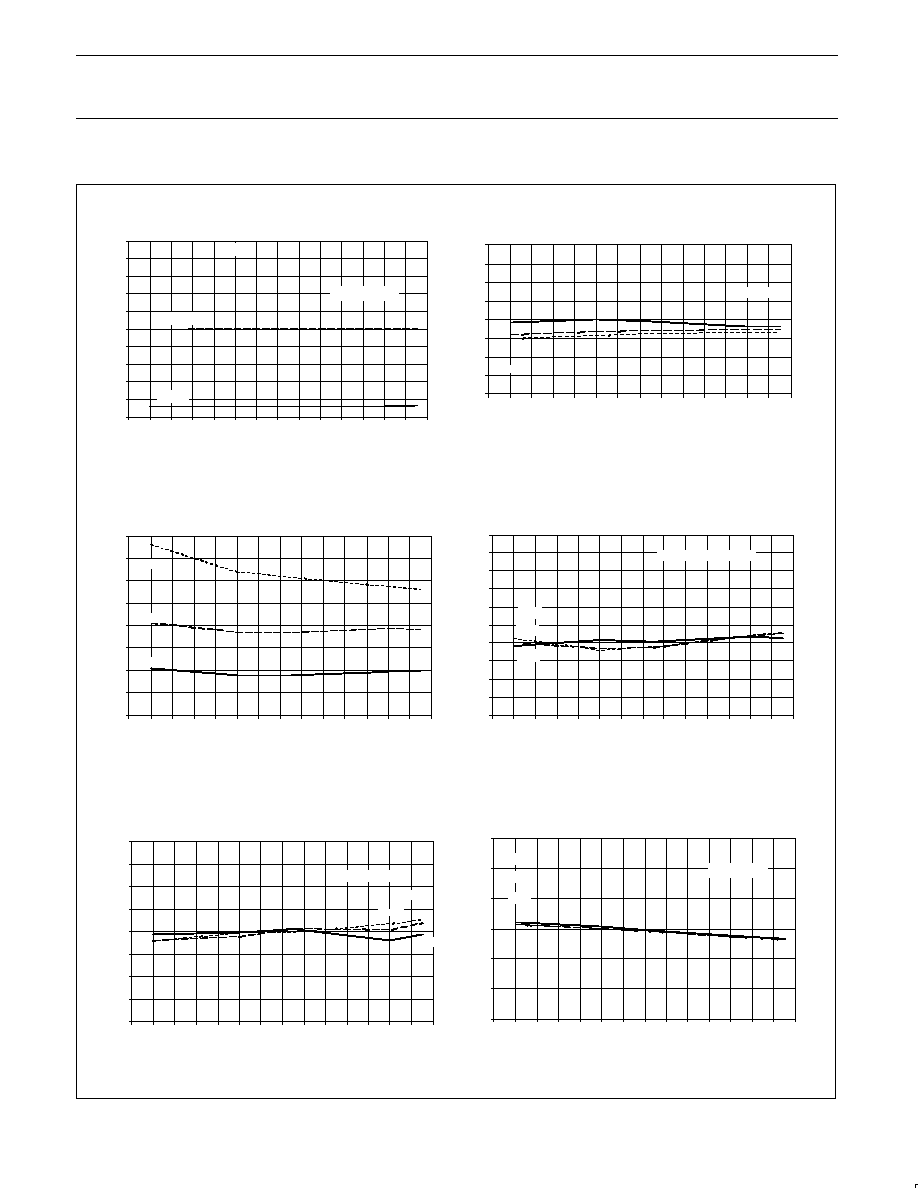
Philips Semiconductors
Product specification
SA1638
Low voltage IF I/Q transceiver
1997 Sept 03
17
TYPICAL PERFORMANCE CHARACTERISTICS
Regulator Dropout Voltage vs. Temperature and V
BATT
Temperature (
∞
C)
5.5V
7.5V
3.3V
I
LOAD
=30mA
-50 -40
-30
-20 -10
0
10
20
30
40
50
60
70
80
90
5
4.5
4
3.5
3
2.5
2
1.5
1
0.5
0
VOL
T
AGE (V)
Regulator Supply Current vs. Temperature and V
BATT
No Load
7.5V
3.3V
5.5V
Temperature (
∞
C)
-50 -40
-30
-20 -10
0
10
20
30
40
50
60
70
80
90
7
CURRENT
(mA)
6.5
6
5.5
5
4.5
4
3.5
3
Regulator Powerdown Supply Current vs.
Temperature and V
BATT
7.5V
Temperature (
∞
C)
-50 -40
-30
-20 -10
0
10
20
30
40
50
60
70
80
90
40
CURRENT
(
A)
35
30
25
20
15
10
5
0
3.3V
5.5V
Regulator Load Regulation vs.
Temperature and V
BATT
7.5V
ILoad = 15mA to 30mA
Temperature (
∞
C)
-50 -40
-30
-20 -10
0
10
20
30
40
50
60
70
80
90
1
REGULA
TION (%)
0.8
0.6
0.4
0.2
0
-0.2
-0.4
-0.6
-0.8
-1
3.3V
5.5V
Regulator Line Regulation vs.
Temperature and V
BATT
I
LOAD
=15mA
Temperature (
∞
C)
-50 -40
-30
-20 -10
0
10
20
30
40
50
60
70
80
90
0.4
REGULA
TION (%)
0.3
0.2
0.1
0
-0.1
-0.2
-0.3
-0.4
7.5V
5.5V
3.3V
Regulator Output Voltage vs.
Temperature and V
BATT
7.5V
I
LOAD
=15ma
Temperature (
∞
C)
-50 -40
-30
-20 -10
0
10
20
30
40
50
60
70
80
90
3.15
VOL
T
AGE (V)
5.5V
3.3V
3.1
3.05
3
2.95
2.9
2.85
µ
Figure 10. Typical Performance Characteristics
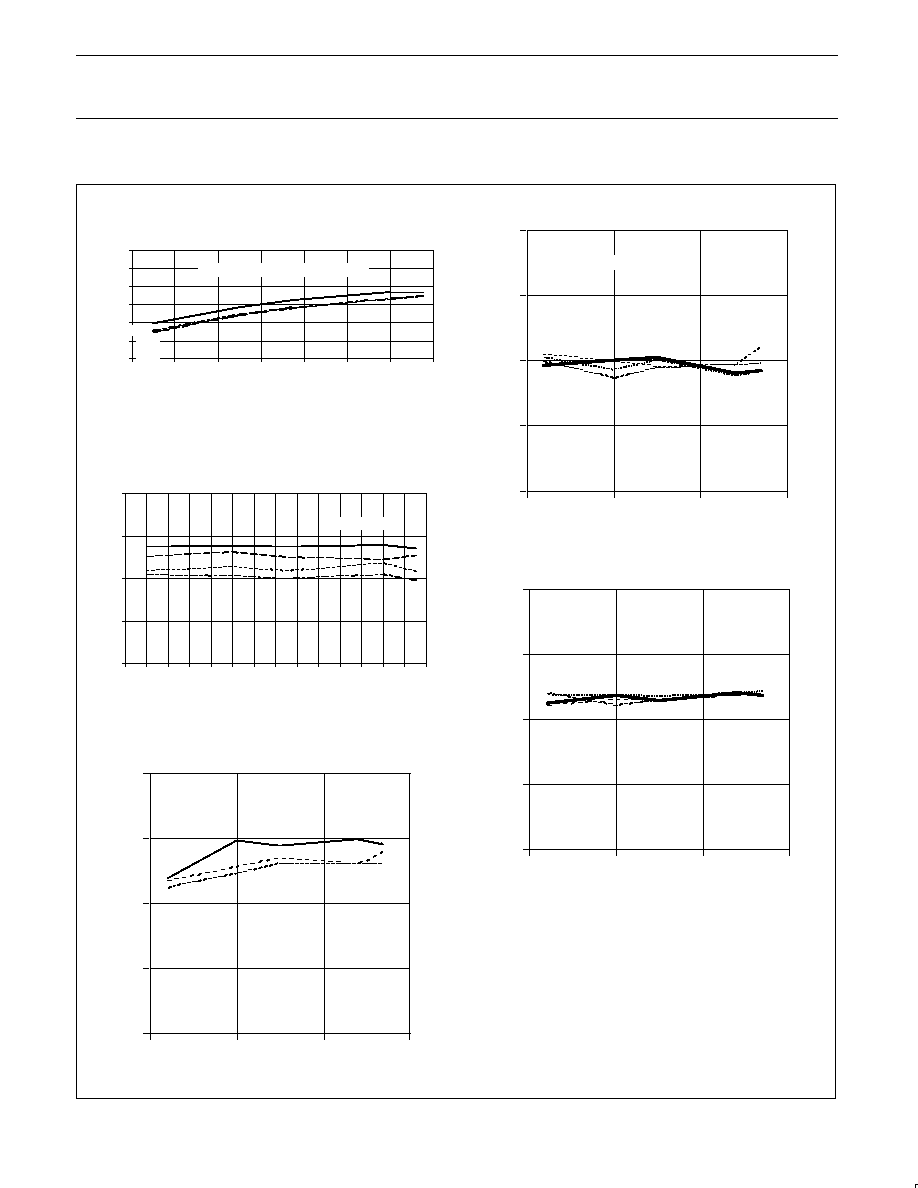
Philips Semiconductors
Product specification
SA1638
Low voltage IF I/Q transceiver
1997 Sept 03
18
TYPICAL PERFORMANCE CHARACTERISTICS (continued)
Transmitter Input Modulation Bandwidth vs.
Temperature and V
CC
TxRx
ITXIN=ITXINX=QTXIN=QTXINX=1.5Vpp
Temperature (
∞
C)
-50
-30
-10
10
30
50
70
90
1100.0
FREQUENCY
(kHz)
1050.0
1000.0
950.0
900.0
850.0
800.0
2.7V
5.5V
4.0V
3.0V
Transmitter Output Second Harmonic Distortion
5.5V
2.7V
4V
3V
Temperature (
∞
C)
-50
SECOND HARMONIC LEVEL
(dBc)
-50
0
50
100
-55
-60
-65
-70
Tx In = 1.5V
P-P
Transmitter Output Third Harmonic vs.
Temperature and V
CC
TxRx
TX
IN
=1.5V
P-P
Temperature (
∞
C)
-50
-30
-10
10
30
50
70
90
-50
DIST
OR
TION LEVEL
(dBc)
-55
-60
-65
-70
5.5V
2.7V
4V
3V
5.5V
2.7V
4V
3V
Temperature (
∞
C)
-60
FOUR
TH HARMONIC LEVEL
(dBc)
-50
0
50
100
Tx In = 1.5V
P-P
-65
-70
-75
-80
Transmitter Output Fifth Harmonic Distortion
5.5V
4V
3V
Temperature (
∞
C)
-60
FIFTH HARMONIC LEVEL
(dBc)
-50
0
50
100
Tx In = 1.5V
P-P
-65
-70
-75
-80
Transmitter Output Fourth Harmonic Distortion
Figure 11. Typical Performance Characteristics (continued)

Philips Semiconductors
Product specification
SA1638
Low voltage IF I/Q transceiver
1997 Sept 03
19
TYPICAL PERFORMANCE CHARACTERISTICS (continued)
Transmitter Output Saturation vs.
Temperature and VccTxRx
3.0V
2.7V
4.0V
5.5V
Temperature (
∞
C)
-50 -40
-30
-20 -10
0
10
20
30
40
50
60
70
80
90
-50
5th HARMONIC DIST
OR
TION LEVEL
(dBc) -52
-54
-56
-58
-60
-62
-64
-66
-68
-70
TXIFOUT=TXIFOUTX=VccTxRx≠0.3V
Transmitter RMS Output Current
vs. Temperature and V
CC
TxRx
5.5V
4.0V
3.0V
2.7V
IF=400MHz
Temperature (
∞
C)
-50 -40
-30
-20 -10
0
10
20
30
40
50
60
70
80
90
1.1
RMS CURRENT
(mA)
1.05
1
0.95
0.9
0.85
0.8
0.75
0.7
0.65
0.6
Transmitter DC Output Current vs.
Temperature and V
CC
TxRx
2.7V
3.0V
5.5V
4.0V
Temperature (
∞
C)
-50 -40
-30
-20 -10
0
10
20
30
40
50
60
70
80
90
2.5
CURRENT
(mA)
2.4
2.3
2.2
2.1
2
1.9
1.8
1.7
1.6
1.5
Transmitter LO Suppression vs.
Temperature and VccTxRx
5.5V
4.0V
3.0V
2.7V
Temperature (
∞
C)
-50 -40
-30
-20 -10
0
10
20
30
40
50
60
70
80
90
-36.0
SUPPRESSION (dBc)
-38.0
-40.0
-42.0
-44.0
-46.0
-48.0
-50.0
Transmitter Side Band Suppresion vs.
V
CC
TxRx and Temperature
2.7V
5.5V
4.0V
3.0V
Temperature (
∞
C)
-50 -40
-30
-20 -10
0
10
20
30
40
50
60
70
80
90
-35
SUPPRESSION (dBc)
-40
-45
-50
-55
-60
-65
-70
Transmit Noise Floor vs Temperature and Supply Voltage
10MHz from Carrier
600kHz from Carrier
2.7V
5.5V
4V
3V
2.7V
3V
4V
5.5V
Temperature (
∞
C)
-50 -40
-30
-20 -10
0
10
20
30
40
50
60
70
80
90
-136
OUTPUT NOISE (dBc/Hz)
-135
-134
-133
-132
-131
-130
-129
-128
-127
-126
Baseband Input = 1.5V
P-P
differential, 30kHz
Figure 12. Typical Performance Characteristics (continued)
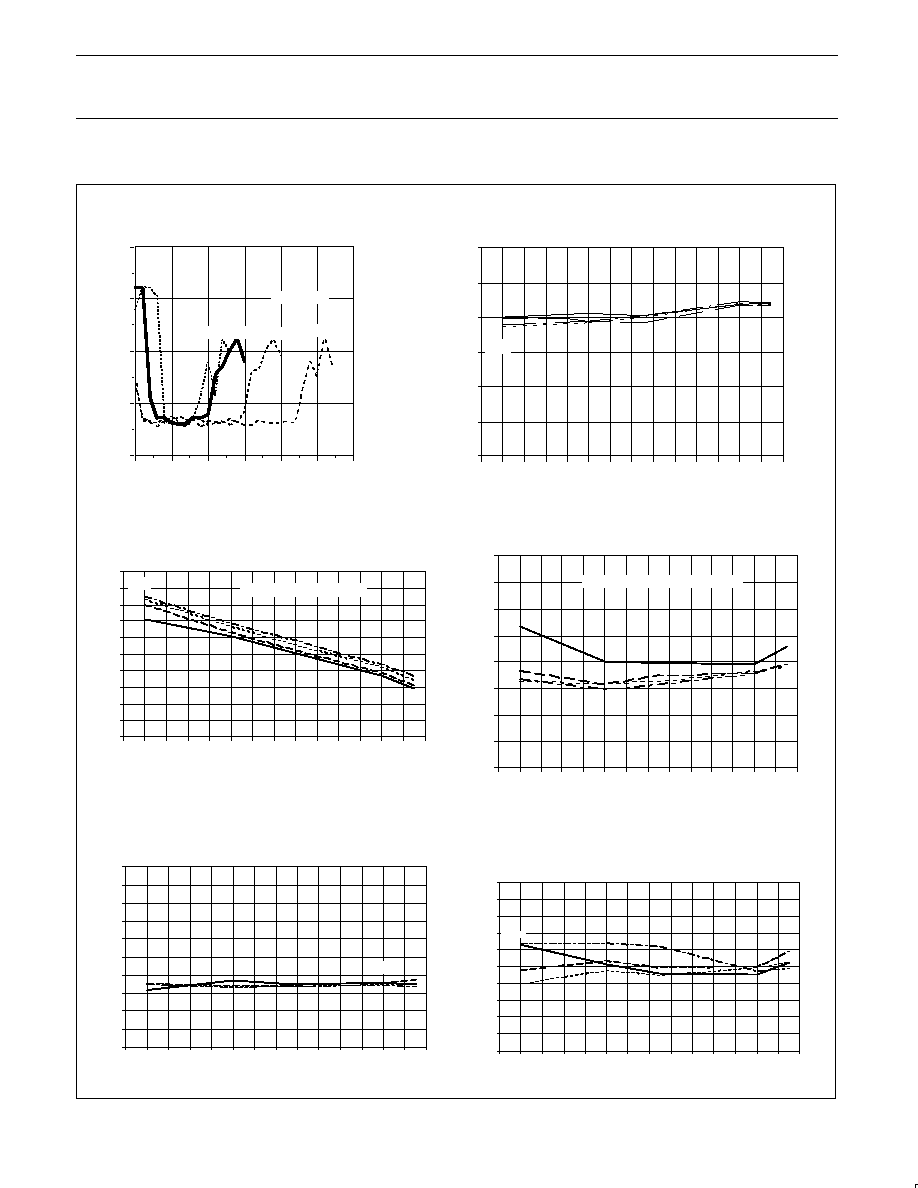
Philips Semiconductors
Product specification
SA1638
Low voltage IF I/Q transceiver
1997 Sept 03
20
TYPICAL PERFORMANCE CHARACTERISTICS (continued)
Transmitter Input Common Mode Range
Vs. Supply Voltage
T = +25
∞
C
4.0V
2.7V
5.5V
3.0V
0
-20
-40
-60
-80
0
1
2
3
4
5
6
COMMON MODE VOLTAGE
5th HARMONIC dBc
Receiver 3dB Bandwidth vs. Temperature and V
CC
TxRx
2.7V
3.0V
5.5V
4.0V
Temperature (
∞
C)
-50 -40
-30
-20 -10
0
10
20
30
40
50
60
70
80
90
100.0
FREQUENCY
(kHz)
90.0
80.0
70.0
60.0
50.0
40.0
Receiver NF vs Temperature and Supply Voltage
Relative to 1200
source resistance
2.7V
3V
4V
5.5V
Temperature (
∞
C)
-50 -40
-30
-20 -10
0
10
20
30
40
50
60
70
80
90
16
NF (dB)
14
12
10
8
6
4
2
0
2.7V
4.0V
3.0V
5.5V
Temperature (
∞
C)
-50 -40
-30
-20 -10
0
10
20
30
40
50
60
70
80
90
1
MA
TCH (dB)
0.8
0.6
0.4
0.2
0
-0.2
-0.4
-0.6
-0.8
-1
Receiver Gain match vs V
CC
TxRx and Temperature
Receiver Channel Matching Phase Error
vs. Temperature and V
CC
TxRx
5.5V
2.7V
3.0V
4.0V
Temperature (
∞
C)
-50 -40
-30
-20 -10
0
10
20
30
40
50
60
70
80
90
5
ERROR ( )
4
3
2
1
0
-1
-2
-3
o
-4
-5
Receiver Gain vs. Temperature and V
CC
TxRx
5.5V
4.0V
3.0V
2.7V
IF=400.005MHz, LO=400MHz
Temperature (
∞
C)
-50 -40
-30
-20 -10
0
10
20
30
40
50
60
70
80
90
60.0
GAIN (dB)
58.0
56.0
54.0
52.0
50.0
48.0
46.0
44.0
42.0
40.0
Figure 13. Typical Performance Characteristics (continued)
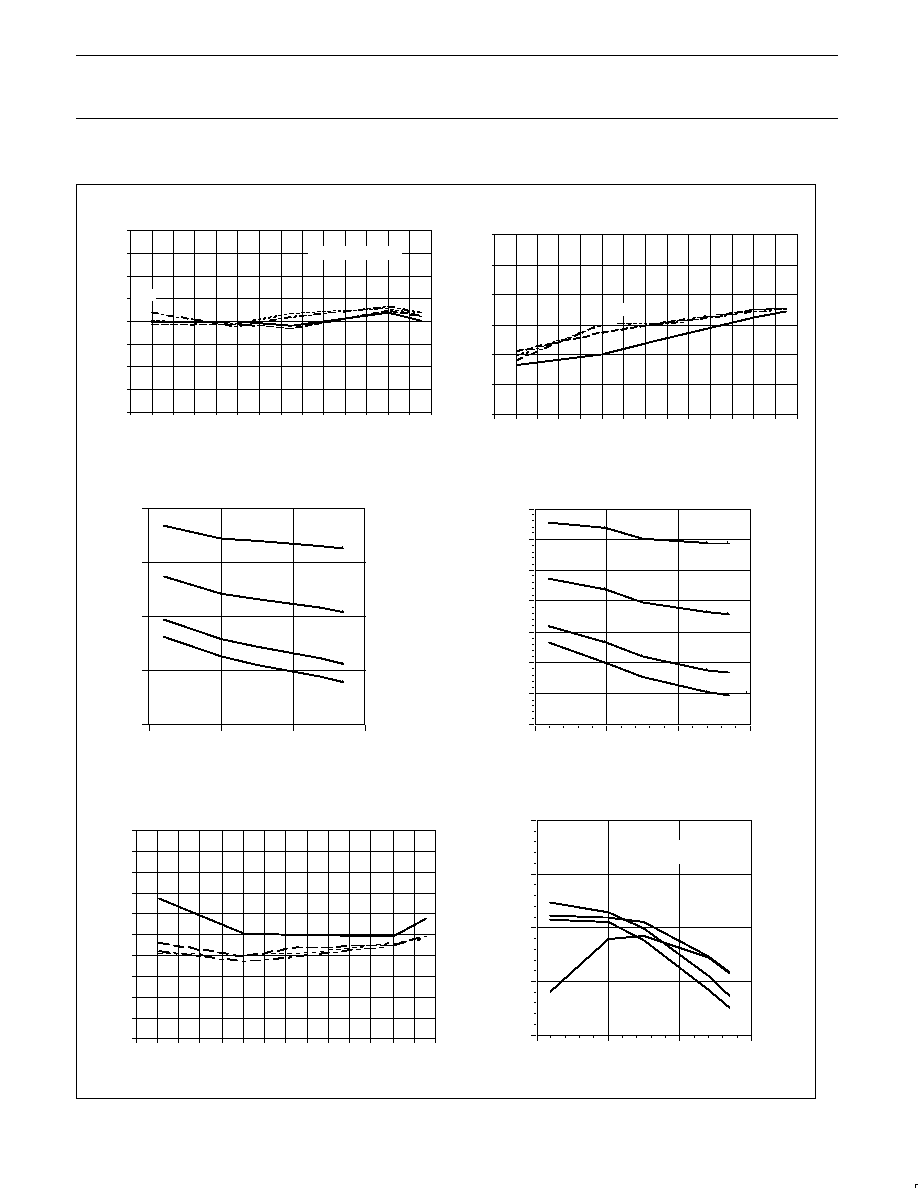
Philips Semiconductors
Product specification
SA1638
Low voltage IF I/Q transceiver
1997 Sept 03
21
TYPICAL PERFORMANCE CHARACTERISTICS (continued)
Receiver Corrected Output Offset Voltage
vs. Temperature and V
CC
TxRx
5.5V
4.0V
3.0V
2.7V
DCRes Resistor=100k
Temperature (
∞
C)
-50 -40
-30
-20 -10
0
10
20
30
40
50
60
70
80
90
200
OFFSET (mV)
150
100
50
0
-50
-100
-150
-200
Receiver In≠band 1dB Compression Point
vs. Temperature and V
CC
TxRx
2.7V
5.5V
3.0V
4.0V
Temperature (
∞
C)
-50 -40
-30
-20 -10
0
10
20
30
40
50
60
70
80
90
-47.0
LEVEL
(dBm)
-49.0
-51.0
-53.0
-55.0
-57.0
-59.0
SA1638 Receiver QRXOUT Voltage
3V
5.5V
4V
2.7V
-50
0
50
100
TEMPERATURE (
∞
C)
PIN 15 DC VOL
T
AGE (V)
1.8
1.7
1.6
1.5
1.4
Reference Voltage
5.5V
4V
3V
2.7V
-50
0
50
100
TEMPERATURE (
∞
C)
VREF (V)
1.8
1.7
1.6
1.5
1.45
1.75
1.65
1.55
LO
IN
Maximum Frequency Div800
5.5V
2.7V
3V
4V
-50
0
50
100
TEMPERATURE (
∞
C)
FREQUENCY
(MHz)
1100
1050
1000
950
900
2.7V
3V
4V
5.5V
Temperature (
∞
C)
-50 -40
-30
-20 -10
0
10
20
30
40
50
60
70
80
90
IP2 (dBm)
Receiver IP2 vs Temperature and Supply Voltage
5.00
4.00
3.00
2.00
1.00
0
-1.00
-2.00
-3.00
-4.00
-5.00
V
LOIN
= 100mV
PEAK
Figure 14. Typical Performance Characteristics (continued)
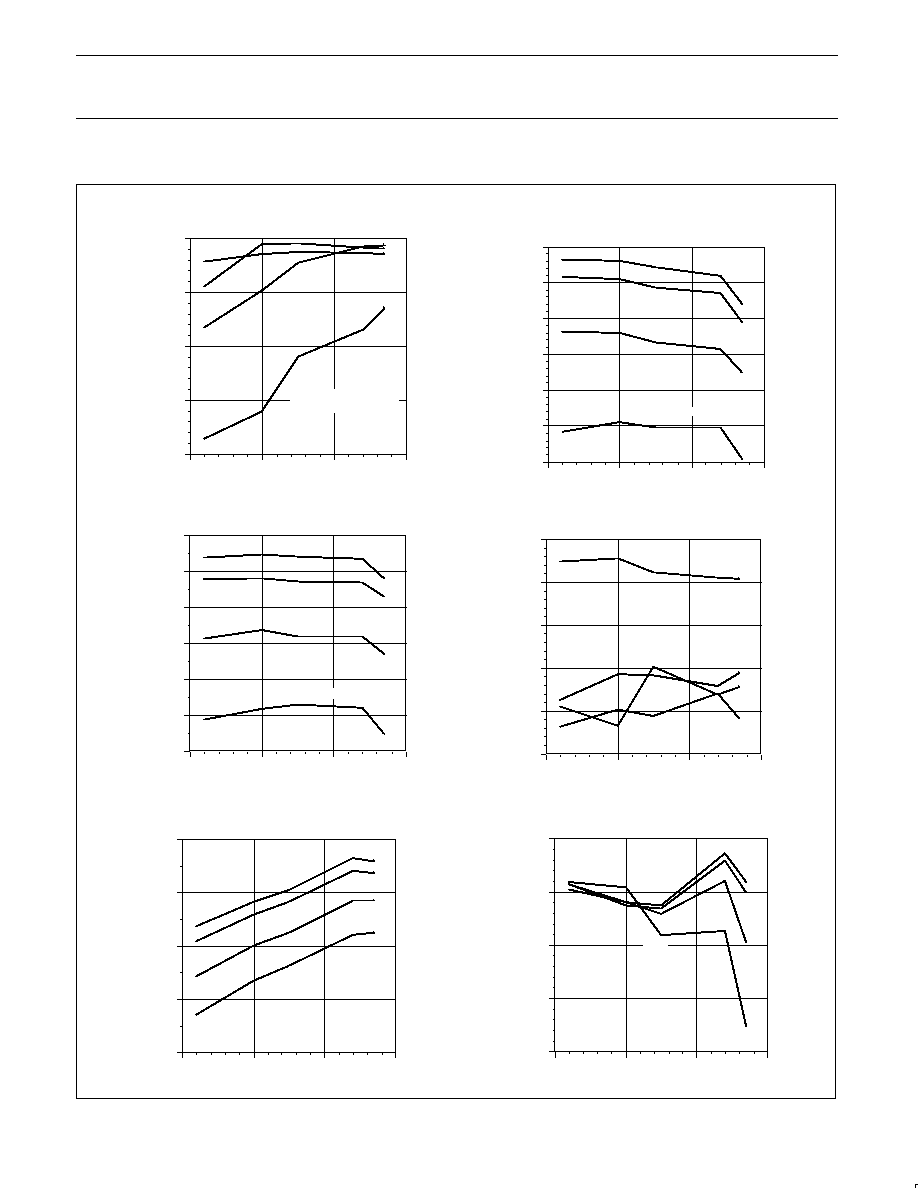
Philips Semiconductors
Product specification
SA1638
Low voltage IF I/Q transceiver
1997 Sept 03
22
TYPICAL PERFORMANCE CHARACTERISTICS (continued)
CLK
IN
Maximum Frequency Div52
5.5V
3V
2.7V
4V
-50
0
50
100
TEMPERATURE (
∞
C)
FREQUENCY
(MHz)
250
225
200
175
150
N Charge Pump
Output Current 000
5.5V
4V
3V
2.7V
-50
0
50
100
TEMPERATURE (
∞
C)
CURRENT
(
A)
-495
-500
-505
-510
-515
-520
-525
µ
P Charge Pump
Output Current 111
5.5V
4V
3V
2.7V
-50
0
50
100
TEMPERATURE (
∞
C)
-1000
-1010
-1020
-1030
-1040
-1050
-1060
N Charge Pump Relative
Output Variation
5.5V
4V
3V
2.7V
-50
0
50
100
TEMPERATURE (
∞
C)
V
ARIA
TION (%)
1.25
1
0.75
0.5
0.25
0
Charge Pump Match
Current 111
5.5V
4V
3V
2.7V
-50
0
50
100
TEMPERATURE (
∞
C)
-20
-30
-40
-50
-60
Charge Pump Output Leakage Current
5.5V
4V
3V
2.7V
-50
0
50
100
TEMPERATURE (
∞
C)
0.25
CURRENT
(nA)
0
-0.25
-0.5
-0.75
CURRENT
(
A)
µ
CURRENT
(
A)
µ
V
CLKIN
= 100mV
PEAK
Figure 15. Typical Performance Characteristics (continued)
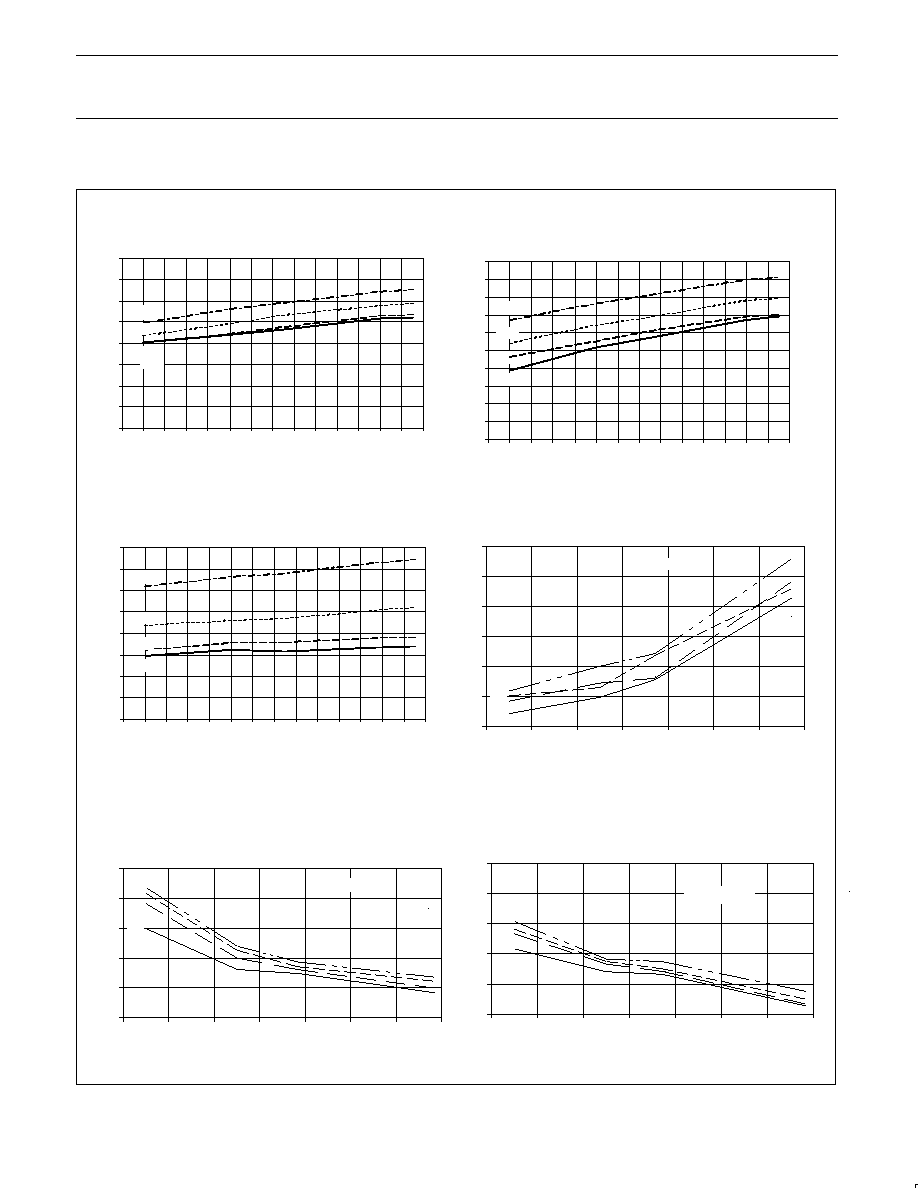
Philips Semiconductors
Product specification
SA1638
Low voltage IF I/Q transceiver
1997 Sept 03
23
TYPICAL PERFORMANCE CHARACTERISTICS (continued)
Receiver Supply Current vs.
Temperature and V
CC
TxRx
Temperature (
∞
C)
-50 -40
-30
-20 -10
0
10
20
30
40
50
60
70
80
90
20
CURRENT
(mA)
19
18
17
16
15
14
13
12
11
10
Power Down Supply Current vs.
Temperature and V
CC
TxRx
5.5V
Temperature (
∞
C)
-50 -40
-30
-20 -10
0
10
20
30
40
50
60
70
80
90
160
140
120
100
80
60
40
20
0
Transmitter Supply Current vs.
Temperature and V
CC
TxRx
Temperature (
∞
C)
-50 -40
-30
-20 -10
0
10
20
30
40
50
60
70
80
90
26
CURRENT
(mA)
24
22
20
18
16
14
12
10
4.0V
3.0V
2.7V
5.5V
4.0V
3.0V
2.7V
5.5V
4.0V
3.0V
2.7V
CURRENT
(
A)
µ
270
265
260
255
250
245
240
-50
-30
-10
10
30
50
70
90
VOL
T
AGE (mV)
TEMPERATURE (
∞
C)
Receiver Uncorrected Output Offset
Voltage vs Temperature and V
CC
TxRx
DCRES = 100k
2.7V
3.0V
4.0V
5.5V
330
-50
-30
-10
10
30
50
70
90
VOL
T
AGE (mV)
TEMPERATURE (
∞
C)
Receiver Output Offset Control Step
Size vs Temperature and V
CC
TxRx
DCRES = 100k
2.7V
3.0V
4.0V
5.5V
320
310
300
290
280
37
-50
-30
-10
10
30
50
70
90
VOL
T
AGE (mV)
TEMPERATURE (
∞
C)
Receiver Output Offset Control Step Size vs
Temperature and V
CC
TxRx
36
35
34
33
32
DCRES = 1M
2.7V
3.0V
4.0V
5.5V
Figure 16. Typical Performance Characteristics (continued)
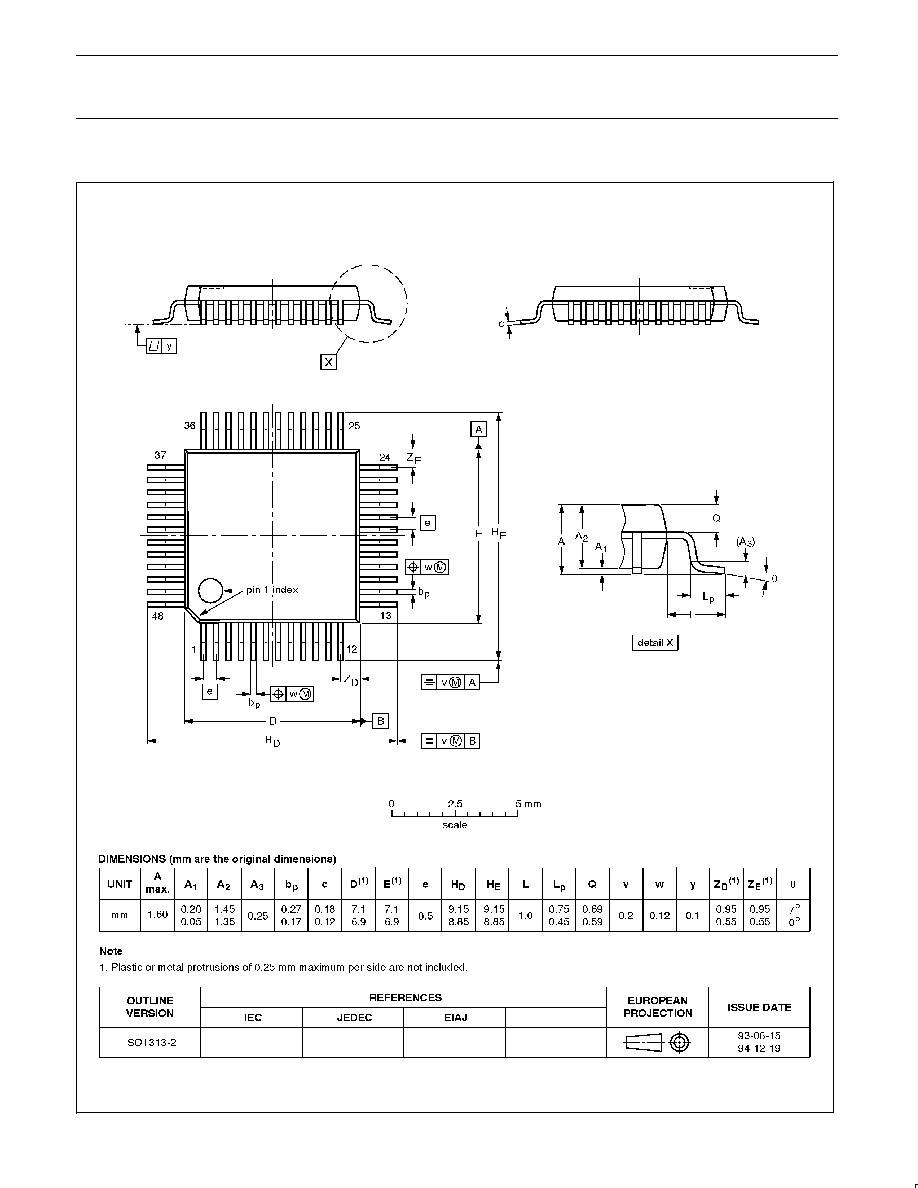
Philips Semiconductors
Product specification
SA1638
Low voltage IF I/Q transceiver
1997 Sept 03
24
LQFP48:
plastic low profile quad flat package; 48 leads; body 7 x 7 x 1.4 mm
SOT313-2

Philips Semiconductors
Product specification
SA1638
Low voltage IF I/Q transceiver
1997 Sept 03
25
NOTES

Philips Semiconductors
Product specification
SA1638
Low voltage IF I/Q transceiver
1997 Sept 03
26
Definitions
Short-form specification -- The data in a short-form specification is extracted from a full data sheet with the same type number and title. For
detailed information see the relevant data sheet or data handbook.
Limiting values definition -- Limiting values given are in accordance with the Absolute Maximum Rating System (IEC 134). Stress above one
or more of the limiting values may cause permanent damage to the device. These are stress ratings only and operation of the device at these or
at any other conditions above those given in the Characteristics sections of the specification is not implied. Exposure to limiting values for extended
periods may affect device reliability.
Application information -- Applications that are described herein for any of these products are for illustrative purposes only. Philips
Semiconductors make no representation or warranty that such applications will be suitable for the specified use without further testing or
modification.
Disclaimers
Life support -- These products are not designed for use in life support appliances, devices or systems where malfunction of these products can
reasonably be expected to result in personal injury. Philips Semiconductors customers using or selling these products for use in such applications
do so at their own risk and agree to fully indemnify Philips Semiconductors for any damages resulting from such application.
Right to make changes -- Philips Semiconductors reserves the right to make changes, without notice, in the products, including circuits, standard
cells, and/or software, described or contained herein in order to improve design and/or performance. Philips Semiconductors assumes no
responsibility or liability for the use of any of these products, conveys no license or title under any patent, copyright, or mask work right to these
products, and makes no representations or warranties that these products are free from patent, copyright, or mask work right infringement, unless
otherwise specified.
Philips Semiconductors
811 East Arques Avenue
P.O. Box 3409
Sunnyvale, California 94088≠3409
Telephone 800-234-7381
©
Copyright Philips Electronics North America Corporation 2000
All rights reserved. Printed in U.S.A.
Date of release: 08-98
Document order number:
9397 750 06847
Philips
Semiconductors
Data sheet
status
Objective
specification
Preliminary
specification
Product
specification
Product
status
Development
Qualification
Production
Definition
[1]
This data sheet contains the design target or goal specifications for product development.
Specification may change in any manner without notice.
This data sheet contains preliminary data, and supplementary data will be published at a later date.
Philips Semiconductors reserves the right to make chages at any time without notice in order to
improve design and supply the best possible product.
This data sheet contains final specifications. Philips Semiconductors reserves the right to make
changes at any time without notice in order to improve design and supply the best possible product.
Data sheet status
[1]
Please consult the most recently issued datasheet before initiating or completing a design.

























